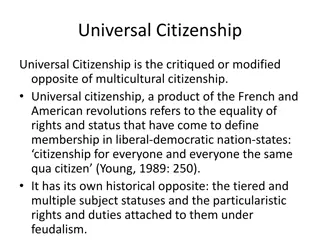Key Considerations for Differentiated ART Delivery
Structural determinants, including criminalization, stigma, and limited access to services, impact key populations seeking HIV treatment. Despite supportive policies, some groups are still excluded, affecting HIV incidence and mortality rates. Challenges in achieving global HIV treatment goals highlight the need for task shifting and tailored service delivery approaches.
Download Presentation

Please find below an Image/Link to download the presentation.
The content on the website is provided AS IS for your information and personal use only. It may not be sold, licensed, or shared on other websites without obtaining consent from the author.If you encounter any issues during the download, it is possible that the publisher has removed the file from their server.
You are allowed to download the files provided on this website for personal or commercial use, subject to the condition that they are used lawfully. All files are the property of their respective owners.
The content on the website is provided AS IS for your information and personal use only. It may not be sold, licensed, or shared on other websites without obtaining consent from the author.
E N D
Presentation Transcript
Differentiated service delivery for key populations: key considerations from a policy perspective Virginia Macdonald, HIV Department World Health Organization #IAS2017 | @IAS_Conference
#IAS2017 | @IAS_conference When you go to visit the hospital, they will not attend to you. In fact I hate going to such hospitals. I do self- treatment from home and I usually use tablets. You know I feel ashamed. I will visit the hospital and everybody will despise me. It is the way female health workers treat me, they make me feel angry and resentful to seek treatment. That makes me feel ashamed. Everybody looks at you. You feel you are not part of the society (Transgender woman, HIV-positive)*. Structural determinants influence HIV risk Criminalisation of behaviours Punitive, restrictive policies Stigma Violence Human rights abuses Reduced access to prevention, testing and treatment services Inconsistent condom or needle/syringe use Increased risk of HIV infection Poor health outcomes Adapted from Shannon K, Strathdee SA, Goldenberg SM, et al. Global epidemiology of HIV among female sex workers: influence of structural determinants. Lancet 2014; 385: 55-71
#IAS2017 | @IAS_conference Despite supportive policy, key populations excluded from treatment Ferro, Culbert et al Physician Decisions to Defer Antiretroviral Therapy in Key Populations: Implications for Reducing Human Immunodeficiency Virus Incidence and Mortality in Malaysia Open Forum Infect Dis 2017 Jan25;4(1)
#IAS2017 | @IAS_conference 100% 90% 80% UNAIDS 2016 Global estimates: % of PLHIV diagnosed 70% 60% UNAIDS 2016 Global estimates: % of PLHIV receiving ART Diagnosed 50% On treatment UNAIDS 2016 Global estimates: % of PLHIV virally suppressed Suppressed 40% 30% 20% 10% 0% FSW, Malawi FSW , Zimb MSM, India FSW, Burkina F PWID, India PWID, EMRO MSM, Russia MSM, Burkina F Adapted from: Risher K et al HIV treatment cascade in MSM, people who inject drugs, and sex workers. Curr Opin HIV AIDS. 2015 Nov;10(6):420-9; Shaw et al Achieving 90-90-90 in the WHO Eastern Mediterranean region: key issues for people who inject drugs (2017) Presented at IAS Conference, Paris; UNAIDS, Global AIDS update 2017
#IAS2017 | @IAS_conference Key considerations for differentiated ART delivery
#IAS2017 | @IAS_conference Task shifting for ART delivery
#IAS2017 | @IAS_conference Decentralising ART delivery In settings where opioid substitution therapy is provided, ART should be initiated and maintained in people who are eligible for ART
#IAS2017 | @IAS_conference Clinically stable key population members are no different from other clinically stable adults and adolescents Specific considerations for people who use drugs Everyone living with HIV who uses drugs should be offered HIV treatment and active drug use should not exclude enrolment ART Some people may require additional support As with all other adults and adolescents receiving ART, the decision to reduce clinic visits should be made on a case-by-case basis ART should be offered at OST clinics strong evidence base
#IAS2017 | @IAS_conference 3-6 monthly 3-6 monthly Every 1-6 months Primary health care OST clinics Community based organizations Prison or other closed setting Phone hotlines Primary health care Community-based organizations, OST clinics Prison or other closed setting Primary health care Community-based organizations OST clinics Prison or other closed setting Nurses Social workers Lay providers Peers Peer navigators Outreach workers Lay providers Peers Peers navigators Outreach workers Clinical officer Doctor (can be seconded to CBOs or through scheduled visits) ART refill Referral check Adherence check Comprehensive services Prevention, including harm reduction Clinical consultation Lab tests, rescript Comprehensive services Prevention, including harm reduction Support after release from prison Peer support Legal support Responding to violence Support after release from prisons Social interventions Psychological interventions
#IAS2017 | @IAS_conference Differentiated service delivery: for inclusion not exclusion
#IAS2017 | @IAS_conference Looking ahead Implementation with evaluation More consideration of non- stable clients Develop of frameworks for: Differentiated service delivery for key populations Differentiated HIV testing services























